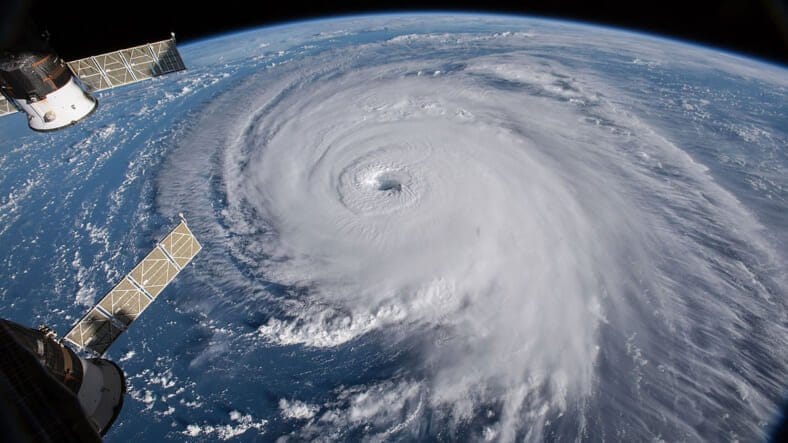Hurricane Season FAQ: Everything You Need To Know

Hurricane season runs from summer to fall, normally lasting from June 1st to November 30th each year. However, many climatologists believe the duration and severity of hurricanes will increase as ocean temperatures continue to rise.
How Do Hurricanes Work?
Hurricanes form in the tropics and gain energy from moist air rising from warm ocean waters. This process draws more humid air into the storm, and as that air cools, the moisture creates clouds heavy with rain. This means, that as long as the ocean waters are warm, the storm grows, gaining energy, and as the Earth’s spin creates motion in the storm (anticlockwise), a hurricane can be born.
What Defines A Hurricane?
Some of the biggest hurricanes have been hundreds of kilometers wide, with wind speeds of up to 322 kilometers per hour. However, not all swirling storms are hurricanes, there is an actual wind-speed requirement for a storm to quality, and that is 119 kilometers per hour.
Interestingly, hurricanes only form in the Atlantic or North-Eastern Pacific oceans. Elsewhere in the world, like the North-Western Pacific, South Pacific, and the Indian Ocean, they are called cyclones or typhoons. Regardless of the name, they are the same weather phenomenon.
Other characteristics of a hurricane include turning calm oceans into violent peaks and troughs, causing 50-foot waves. Plus, devastating coastlines and neighboring towns and cities with heavy rain, brutal wind, and more.
What Is Hurricane Season?
The Northern Hemisphere experiences hurricane season between June 1st and November 30th. During this time, hundreds of tropical storms form around the equator, and around 50 build up enough intensity to become classified as a hurricane. However, only a few make it to land.
In the Southern Hemisphere, hurricane season runs from January to March, only. However, if you consider January to November is covered by a hurricane season somewhere, that means 92% of the time, someone somewhere is living in the knowledge that their life could be impacted by a hurricane, typhoon, or cyclone.
Also Read: 5 RV Upgrades That Will Improve Your Vacation
Hurricane Categories
As a hurricane gains speed, rotating-ever faster, low-pressure forms at the center. The quicker the wind speed around the eye, the higher it rates on the Saffir-Simpson hurricane wind scale.
- Category 1: Sustained winds of 119 to 153 kilometers per hour. This could damage a roof, break tree branches, uproot less-deep rooted trees, and even cause power outages.
- Category 2: Sustained winds of 154 to 177 kilometers. This could cause downed power lines and major structural damage to streets and houses.
- Category 3: Sustained winds of 178 to 208 kilometers per hour. Major damage to essentials, including water supplies and electricity.
- Category 4: Sustained winds of 209 to 251 kilometers per hour. Extensive damage to property, businesses, and services. Essential services could be under pressure for months after the hurricane, putting everything back to normal.
- Category 5: Sustained winds of 252 kilometers per hour or higher. These hurricanes cause massive devastation that can take years to put right.
Hurricane Katrina in 2005 was category 5. It took 1,833 people’s lives, as the storm surged along the Mississippi coast, It also destroyed structures for several miles inland, causing between $81-and-$150-billion in property damage.
Why Are Hurricanes Named?
Meteorologists name hurricanes because there are often several swirling across oceans at the same time. Therefore, naming them helps in monitoring.
Importantly, there is a naming convention per hurricane season. The first hurricane of the season is given a name starting with the letter A. The second would then start with the letter B, and so on. Names are also drawn from lists based on the regions they are going to impact, with Pacific Ocean names being different from Atlantic Ocean names.
Interestingly, if a hurricane causes major damage, a nation can request the name be retired for 10 years.
How Are Hurricanes Predicted?
Over the years, massive advances have been made in the ability to predict when and where a hurricane will form. This is largely down to satellites and supercomputers that handle meteorologists’ weather models with incredible accuracy.
There are two factors to hurricane prediction, the first is predicting intensity, and the second is whether it will make landfall.
By using data from previous hurricanes, factoring in weather conditions, and using state-of-the-art technology, accuracy is improving. For example, in the 1980s, predictions were often off by 650km, today, this is now accurate within 185km.
Also Read: Camping Checklist – Essentials You Need For Family Fun Outdoors
Explore More About:Lifestyle